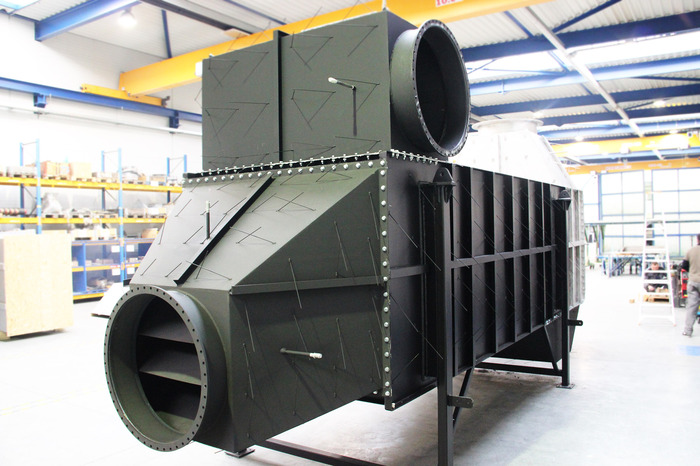Introduction
Air preheater exchangers are integral components in industrial systems designed to improve energy efficiency and reduce operational costs. By utilizing the principle of heat exchange, they recover waste heat from hot exhaust gases or other high-temperature fluids and transfer it to incoming air. This process significantly lowers the amount of energy required to heat the air, making it more energy-efficient. Air preheaters are widely used in sectors like power generation, chemical processing, and HVAC systems, where high-temperature operations are prevalent. They not only enhance combustion efficiency but also help in reducing fuel consumption, lowering greenhouse gas emissions, and complying with stringent environmental regulations. With their ability to optimize heating processes and recover valuable energy, air preheater exchangers are key to improving the overall sustainability of industrial operations.
Functionality
The primary function of an air preheater is to transfer heat from hot exhaust gases (or other high-temperature sources) to cooler incoming air. This process reduces the energy required to heat the air to the desired temperature. By recovering heat that would otherwise be lost, air preheaters reduce fuel consumption, increase thermal efficiency, and contribute to overall system optimization. In power plants, for instance, they play a vital role in improving boiler performance.
Types
- Regenerative Air Preheaters:
These feature rotating heat storage elements made of materials like metal or ceramic. The elements alternate between exposure to hot flue gases and cold air, transferring heat efficiently. Regenerative designs are particularly suited for high-capacity operations, such as large power plants. - Recuperative Air Preheaters:
These consist of stationary surfaces, such as tubes or plates, where hot gases and air flow in separate channels. They are simpler in design, making them suitable for smaller or medium-sized systems. Their durability and straightforward maintenance make them popular in industries with moderate heat recovery needs.
Unique Benefits
- Fuel Efficiency:
By preheating the air, less energy is required for combustion, significantly reducing fuel costs. In some industrial systems, fuel savings can reach 20-25%, which translates to substantial cost reductions over time. - Emission Control:
Preheated air ensures more complete combustion of fuel, leading to lower emissions of pollutants such as carbon monoxide (CO), nitrogen oxides (NOx), and sulfur oxides (SOx). This supports regulatory compliance and sustainability goals. - Compact Design:
Modern air preheaters are designed to fit in tight spaces, with modular components that make them easy to transport, install, and integrate into existing systems.
Innovative Materials
To enhance durability and performance, air preheaters often utilize advanced materials:
- Ceramic Coatings: Resist high temperatures and prevent corrosion in harsh environments.
- Stainless Steel and Alloys: Commonly used for their strength and resistance to scaling.
- High-Temperature Resistant Paints: Applied to surfaces exposed to corrosive or acidic flue gases to prevent degradation.
Applications
- Power Plants: Improve the efficiency of boilers and turbines by preheating air used for combustion. This reduces coal or gas consumption and enhances energy output.
- Chemical Industries: Provide preheated air for catalytic reactors or dryers, optimizing chemical reactions and drying processes.
- HVAC Systems: Preheat air for heating large commercial or industrial spaces, improving energy efficiency and comfort levels.
Design Features
- Variable Surface Area: Adjustable heat transfer surfaces allow operators to adapt the system for varying operational loads, maximizing performance during peak and off-peak periods.
- Self-Cleaning Mechanisms: Particularly in rotary preheaters, cleaning mechanisms like soot blowers prevent fouling and ash buildup, ensuring consistent efficiency.
- Energy Recovery Systems: Some air preheaters integrate with economizers, further enhancing energy recovery by using exhaust heat to preheat boiler feedwater.
Challenges and Solutions
- Fouling and Corrosion:
Flue gases often contain particulates or corrosive elements that can accumulate on surfaces, reducing efficiency. Solutions include anti-fouling coatings, routine maintenance, and the use of materials resistant to corrosion. - Efficiency Drop in Cold Climates:
In colder environments, preheaters may struggle to reach optimal temperatures. This can be mitigated by incorporating auxiliary heating elements or insulated designs to reduce heat loss.
Emerging Trends
- Digital Monitoring:
IoT-enabled sensors provide real-time data on heat exchanger performance, allowing for predictive maintenance and efficient operation. Alerts can notify operators of fouling or pressure drops, minimizing downtime. - 3D-Printed Components:
Additive manufacturing enables the production of lightweight, customized components that can improve heat transfer and reduce material costs. - Waste Heat Utilization:
Modern air preheaters are increasingly integrated with waste heat recovery systems that capture additional energy for secondary processes, such as preheating water or generating steam.
Environmental Impact
Air preheaters contribute significantly to environmental sustainability. By recovering waste heat, they lower the overall energy consumption of industrial systems. This reduces greenhouse gas emissions, particularly in sectors like power generation and manufacturing. Moreover, by supporting cleaner combustion, they help industries meet stringent environmental regulations.
Conclusion
Air preheater exchangers are essential technologies for industries aiming to maximize energy efficiency and reduce environmental impact. These devices contribute significantly to fuel savings by recovering and reusing heat that would otherwise be lost, helping businesses reduce their energy consumption and operating costs. Moreover, by improving combustion processes, air preheaters help decrease harmful emissions like carbon dioxide (CO2), nitrogen oxides (NOx), and sulfur oxides (SOx), which aligns with global sustainability goals and regulatory requirements. With advancements in design, material science, and automation, air preheaters are becoming increasingly efficient, durable, and versatile, capable of meeting the specific needs of diverse industrial applications. Their adoption is not just a cost-effective solution but a strategic step toward achieving long-term energy conservation and environmental responsibility in various industries, ensuring a greener future for industrial operations.

